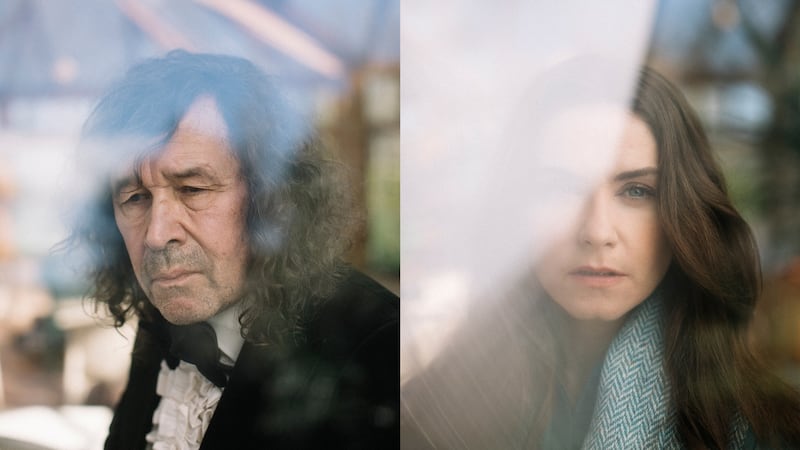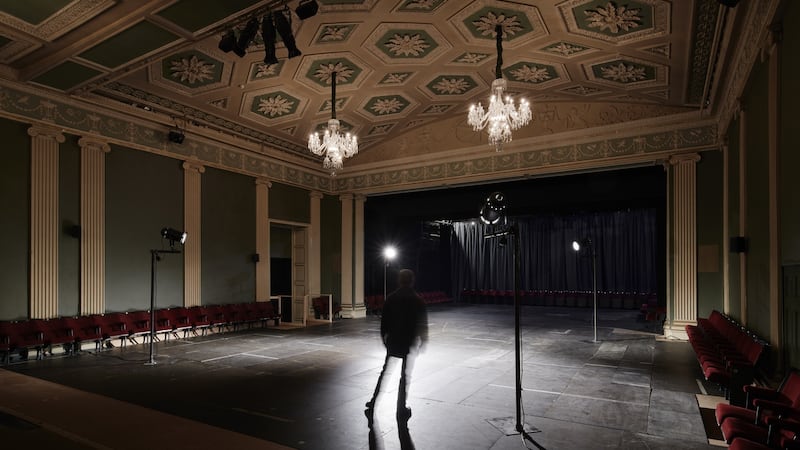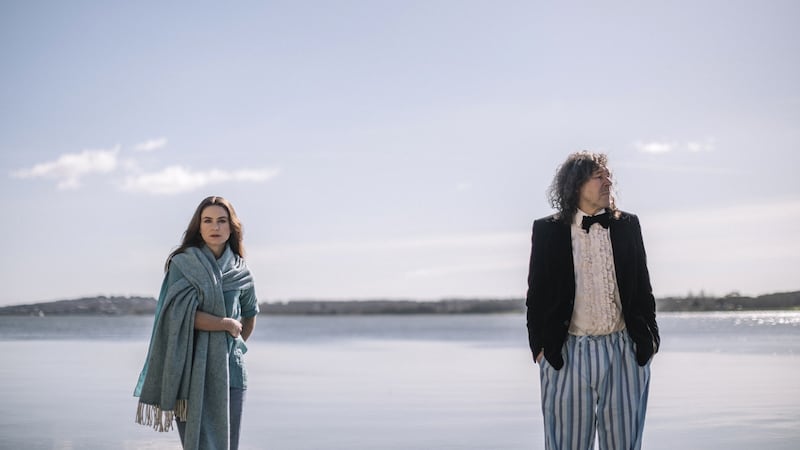There’s a gulp when you see it. Outside, the audience doors into Dublin’s Gate Theatre from Parnell Square, before ascending towards the auditorium, are locked by a heavy security gate. One of the linchpins of Irish theatre for almost a century has been dark for over a year now.
The other door to the right opens, and inside all is still, just three staff, expecting this visitor, Covid protocols at the ready. Selina Cartmell, director and CEO, leads the way upstairs and inside.
We’re on the stage, she says. The sense of strange is not just because this space, scene of so much drama, is unnaturally stilled; since the metaphorical curtain fell on Our New Girl in March 2020 it’s been frozen by pandemic. It’s also unsettling because the space has been reconfigured: rows of seats removed and the floor raised to the level of the stage, creating a large, open “creative studio space”, at a higher level.
The familiar proscenium arch and period plasterwork remind you it’s still the same auditorium. The new floor level is a third of the way up the door from the foyer. Around the cavern’s perimeter is a single row of the Gate’s tip-up seats. In the centre are two seats about three metres apart. We sit.

This space will host a reawakening, with a splash. The world premiere of a new Frank McGuinness play is a two-hander written for Stephen Rea and Judith Roddy, and directed by Caitríona McLaughlin, her last gig before taking over as artistic director of the Abbey Theatre. The Visiting Hour is durational, the length, in real time, of a nursing home visit during Covid.
A daughter visits her father through a window. “His mind is beginning to wander, but conversations about the past can be dangerous, and family memories can look very different, depending on who is telling the story.”
After rehearsal, it’ll be filmed here in 360 degrees by multiple cameras on April 21st, then streamed at 7.30pm on the following three nights. The creative team (Paul Keoghan on lighting, Katie Davenport on design, Tom Lane on sound/composition) is up and at it, and photos were taken this afternoon in Rea’s garden.
That storytelling felt urgent and essential. There's a transformative quality. It's a lovely way to bring one of the great Irish living playwrights back to the Gate
In Christmas week, a welcome present landed in Cartmell’s inbox from McGuinness, whose last play there was Gates of Gold in 2002, before her time. She’d been thinking about “that disconnection of connection, with family not being able to touch. I remember thinking, wouldn’t there be a glorious tension to that in a play.”
And there it was, a sort of serendipity. She was “struck by the simplicity, the beauty of his writing, where we’re all at in terms of the desperate desire to connect with our loved ones, and this distance, not being able to do so. That storytelling felt urgent and essential. There’s a transformative quality. It’s a lovely way to bring one of the great Irish living playwrights back to the Gate.”
The Gate is coming back with panache. After the pandemic stopped live performance in its tracks last March, many theatres, venues, production companies and festivals responded with agility and imagination, creating streamed or outdoor performances, when permitted. The Gate, one of only two full-time producing theatres in Ireland, and recipient of the Arts Council’s second-largest theatre grant, of €1.2 million, was conspicuously invisible for over a year. Which begs questions about why it chose silence.
“I wish it was a decision,” says Cartmell. “I wish we had choice. Why wouldn’t we, if we had the money to do so? If we had the resources we would have done it.” But even a modest monologue would involve paying artists and creatives, plus the cost of filming and livestreaming; “you can’t do that for nothing. We looked into all sorts of ways.” Even small-scale streaming might have cost over €25,000, plus artists and designers.

She acknowledges people may think “how on earth is the Gate, with the chandeliers and . . . There is a perception out that we are an incredibly rich theatre,” but “we were really struggling last year, the money we did have we used as conservatively as we could. We didn’t have the resources to invest in streaming and artists.”
The last year was, she says, “a fight for survival. We were fighting for our lives.”
The Gate announced last summer that it would remain closed until 2021, cancelling over nine months of plays, because the loss of box office made staging in 2020 unsustainable. The Gate has long been heavily dependent on ticket sales, making up 67 per cent of turnover, with 23 per cent from Arts Council investment and 10 per cent from fundraising. Arts Council support is €1.2 million, while operating costs are €1.8 million.
“Normally, box office keeps the whole thing ticking over. And that’s where the business model itself was exposed. The box office fell off that cliff edge overnight.” Cartmell describes the Gate’s structural underfunding as an “underlying precondition”.
I'd love this to be about the phoenix rising from the ashes, because the Gate has been around for 92, 93 years. We're still here. Last year was a real crisis
She sketches it out. The fixed costs seem enormous. Between rent on the theatre (owned by the Rotunda hospital) and offices nearby, utilities, insurance, upkeep of the historic premises, plus four staff to run it, the buildings alone cost about €700,000 a year. To pay salaries and other contractual operating costs, the theatre’s management deferred rent between March and October. But rent was not discounted, and eventually had to be paid in full.
Then they had to “unproduce” several planned 2020 shows, having spent €300,000 on production. They were grateful some who had booked tickets opted not to take a refund; 6 per cent of advance bookings, worth €8,000, were gifted to the Gate, and it refunded €135,000.
They laid off 34 staff early on, including from box office and bar. Senior management took up to 40 per cent pay cuts for a period. Some did three-day weeks. The theatre has used the Temporary Covid-19 Wage Subsidy Scheme (TWSS) and the Employment Wage Subsidy Scheme (EWSS) since March 2020.
“If it wasn’t for the wage subsidies, to be honest with you, we wouldn’t have... That was huge help at the time.”
Just 13 staff remain (including a producer, facilities operations manager, financial controller, production manager, administrator, company manager and marketeer), with 11 of them receiving €350 per week under the EWSS, accounting for 30 per cent of the current wage bill. In 2020 salaries totalled €1,257,777; this year that’s €950,000, because of subsidies and changing roles. If the EWSS extends to June, the subsidy will be about €100,000, but overheads including cleaning and safety are up due to Covid. The total overhead line for 2021 is €1.73 million. It’s dismaying that this doesn’t include paying performers or designers, or having any drama to put on stage at the end of it.
Arts Council Emergency Stabilisation Funding of €501,000 came through in October (“a huge sigh of relief”). It meant they could pay the back rent, and keep going. It was not for artistic output but “to stabilise the organisation from insolvency”.
Was it really that close? “Well, there were a number of very near death experiences in 2020. I’d love this to be about the phoenix rising from the ashes, because the Gate has been around for 92, 93 years. We’re still here. Last year was a real crisis.”
Barely a wet weekend after starting the new job in 2017, Cartmell and the board had to deal with the fallout when a number of former workers alleged harassment by former director Michael Colgan, leading to a large-scale external inquiry and report.
It was a trauma for the organisation, Cartmell agrees. But with audiences stabilising (after some shakiness, 2019’s box office averaged 82 per cent; “we were doing the numbers”) and a run of Ruth Negga in Hamlet in New York, by March 2020 “I feel we had really turned a corner. The Gate was on the cusp of that journey, coming back. Momentum was beginning to build again. Then everything had to stop.”

Well before the Covid layoffs, there were several departures, some of them redundancies, from the Gate, including three or four senior staff of long standing. “Things have to change,” Cartmell says. “That’s the natural course.” Was that behind the departures? “I think change is good, change is necessary. I think I was brought in to do that. Culturally, with all these new ways of working, there’s always going to be changes that are necessary and that’s just the way it is.” With new practices, new stories, new artists, “it’s bound to happen, you’re shaking it up”.
It’s not as black-and-white, she says, as a conflict between new and old culture, with one opposed to the other. “The only way to create art is through collaborating. That’s part of the creative act.”
Regarding perceptions of large staff turnover in a small organisation, Cartmell points out it’s across four years. “I don’t think a huge number of people left. People have come and gone. I don’t think there’s been a sense of an exodus.”
With an outstanding record as a creative stage director, the chief executive function was newer to her. “It would be difficult for anyone, balancing so many things: juggling leadership, management, the creative-artistic piece, building teams, making sure there’s audiences coming in to see the work.”
It's a huge thing for us right now, to be able to talk about a new piece of work. It's a great team, and a warm feeling to be able to share that
Which was most challenging? “All of them in their own ways. It’s been a challenging few years. With that there needs to be resilience and change and progression and different ideas and artists and stories and audiences” to “keep the Gate alive, and ready for its centenary” in 2028.
She talks about wanting to create the best work, in the safest possible environment, for people to feel supported, and feel that everyone is on board. “You’re only as good as the people you work with.”
She’s optimistic various plans and hopes in the works, including new plays and a touring show outdoors this summer, will be able to happen. They’ve explored audience options: cabaret-style, pods of tables, rows of seats. But a reliance on full houses – 371 seats in the compact auditorium – while social distancing sounds an impossible equation.
So she and the board are “reimagining a new business model for the Gate, because of how exposing it was for us in 2020” being heavily dependent on box-office income. She mentions new partnerships, a “new ecosystem”, filming, moving beyond “silo programming”, creating “a more resilient, robust, flexible model”.
Meantime, “it’s a huge thing for us right now, to be able to talk about a new piece of work.” It’s not in front of a live audience but “there will be a time for that. It’s a great team, and a warm feeling to be able to share that.”
After the past year’s “survival mode”, she says, “we’re now saying, we’re back. It was incredibly difficult. I am incredibly proud of the last four years and how hard everyone has worked to make this place what it is.”
Recovering from traumas, The Visiting Hour represents the Gate aiming to pick itself up, dust off, to start all over again.



















